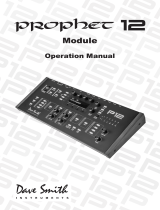
Arpeggiator ........................................... 54
Arpeggiator “Momentary Sustain” Mode ..........................56
MIDI Note Output from the Arpeggiator ...........................57
Arpeggiator Parameters (Display Menus) .........................58
Clock Parameters ......................................59
Sequencer ............................................ 60
Normal, Gated, and Trigger Modes ..............................60
Programming the Sequencer ...................................62
Recording Phrases/Sequences A,B,C, or D. .......................63
Sequencing Parameter Changes in Real-Time .....................64
Copying a Sequence from One Track to Another ....................65
Copying and Pasting an Entire Sequence .........................65
Muting a Sequence Track. . . . . . . . . . . . . . . . . . . . . . . . . . . . . . . . . . . . . . 66
Creating An Extended Sequence ...............................66
Paraphonic Sequencing ......................................67
Adding Rests, Ties, and Velocity ................................68
Editing Duration .............................................72
Adding Ratcheting ...........................................72
Editing Other Elements of a Sequence ...........................73
Setting or Changing the Destination of a Track .....................74
Recording Additional Sequencer Tracks for Modulation. . . . . . . . . . . . . . . 75
Using Slew .................................................76
Turning off the Sequencer’s “Notes” Track ........................76
Sequencer Parameters (Front Panel) ............................77
Additional Sequencer Parameters (Display Menus). . . . . . . . . . . . . . . . . . 78
Cue Program .......................................... 79
Tuned Feedback ....................................... 80
Feedback Parameters ........................................81
Master Volume/Program Volume .......................... 82
Transpose ............................................ 83
Hold ................................................. 83
Glide ................................................. 83
Glide Modes ................................................84























